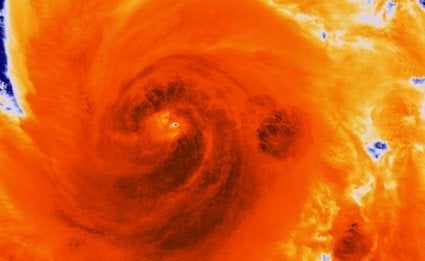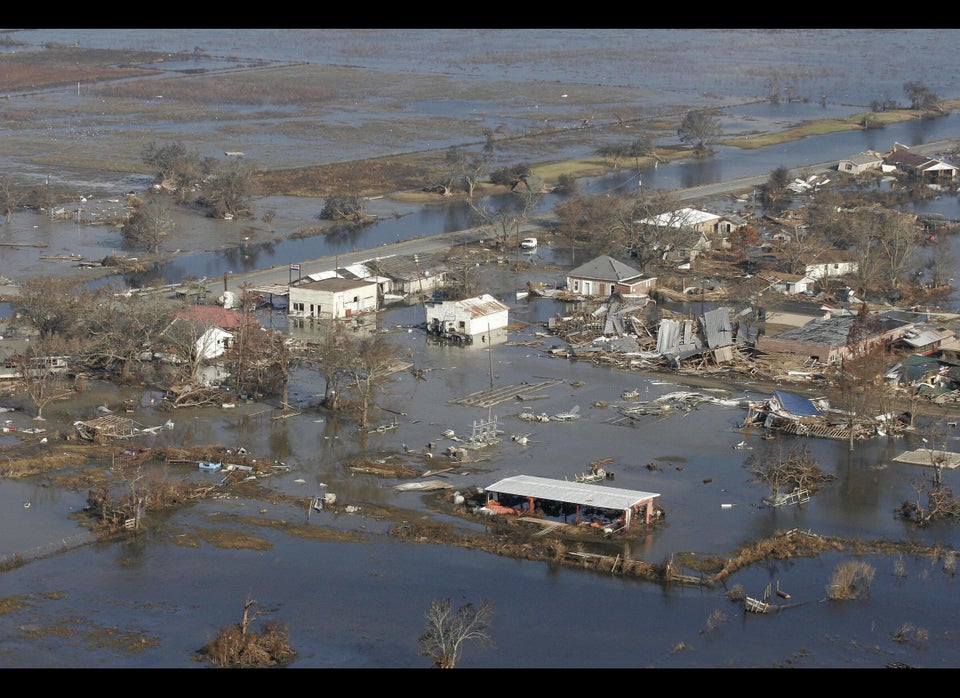
BOSTON — Automatic budget cuts set to take effect March 1 could add to the woes of the federal government’s troubled weather satellite programs, jeopardizing future forecasts, a top official said Friday.
“It’s not going to be pretty,” outgoing National Oceanic and Atmospheric Administration chief Jane Lubchenco said of the package of across-the-board spending cuts known as “sequestration.”
“The sequester has the potential to wreak havoc with so many different things, and satellites loom large within that,” she told reporters at the annual meeting of the American Association for the Advancement of Science. “There’s just so much uncertainty. Nobody knows how long it might last, and it’s very difficult to plan for that.”
The VIIRS sensor on the NOAA/NASA Suomi NPP satellite passed over the central eye of Hurricane Sandy on Oct. 25, 2012. Without the satellite data, NOAA’s weather forecasts would become less reliable.
Credit: JPSS/NOAA/NASA
The sequestration cuts, which will take effect unless Congress can overcome political gridlock and approve a new spending deal, would chop 8.2 percent from the operating budgets of most federal agencies, including NOAA, the White House Office of Management and Budget estimates.
“The way it is structured, [sequestration] applies to every single line item” in NOAA’s budget, said Lubchenco, who will leave her post at NOAA next month. “We don’t have a lot of discretion to say this is more important than that. Everything gets whacked.”
And that could further delay the launch of the nation’s next polar-orbiting environmental satellite, adding to the likelihood of a gap between probes collecting data that powers the nation’s weather forecasts.
NOAA has warned for several years of a near-certain gap in data collected by the nation’s current polar-orbiting satellite, Suomi NPP, and its replacement, JPSS-1.
That’s because Suomi, which launched in late 2011, was designed to operate for at least five years. But JPSS-1, won’t reach orbit until early 2017 — or later.
And that is setting up a potential gap in key weather data that could last anywhere from 17 to 53 months, the Government Accountability Office warned this week in its annual analysis of federal programs at “high risk” for waste, fraud, abuse and mismanagement, or those “needing broad-based transformation.”
It sounds wonky. But without that polar-orbiting satellite data, NOAA’s weather forecasts would become less reliable. The agency has calculated that it would have underestimated the amount of snow that fell during the “Snowmageddon” blizzard that hit the East Coast in 2010 by 10 inches. And its forecasts would have placed the center of the storm 200 to 300 miles away from its actual epicenter.
And forecasters at the European Centre for Medium-Range Weather Forecasts, who use data from U.S. polar-orbiting satellites, said that without that information, their weather model would not have accurately projected the path of Hurricane Sandy.
With that in mind, Lubchenco said she’s concerned that the looming budget cuts could add to the gap in satellite data that NOAA is already struggling with. Budget shortfalls in 2011 helped create that gap, she said.
NOAA is “doing everything possible to not have further delays, which means in large part having really good management and adequate funding,” Lubchenco said. “And the adequate funding is a very big challenge in today’s fiscal climate.”
As her four years at NOAA draw to a close, Lubchenco said the Obama administration has worked aggressively to combat climate change, but could do more.
President Obama “has always taken climate change seriously, which is why he set in motion a number of things that have been very, very important,” Lubchenco said. “Many of the actions that (the Environmental Protection Agency) has undertaken are very, very important steps in the right direction.
“Do they go far enough? No. Will we see more? I sure hope so.”
Lubchenco also told reporters that “bizarre,” “crazy” weather has come to define her term at NOAA’s helm.
“In the last four years, we’ve had 650 major tornadoes, 51 Atlantic hurricanes, six major floods, three tsunamis, persistent drought, numerous heatwaves and recordbreaking snowfall and blizzards,” she said, ticking off what she described as an “extraordinary” laundry list of natural disasters.
In the end, Lubchenco said, she has few regrets about her government tenure.
“I’m immensely proud of all the things we have done over the last four years,” she said.
Related Content
Sans Polar Satellites, Hurricane Sandy Forecasts Would Have Suffered
Weather, Climate Forecasts Imperiled as Programs Cut
NOAA Seeks Public Input on Looming Satellite Gap
Follow the author on Twitter @lmorello_dc or @ClimateCentral. We're also on Facebook & other social networks.
